At Domaine De Marie Church, visitors can marvel at the architectural beauty with a distinctly European flair right in the heart of Da Lat. Join Vietnampeace.com to explore the most remarkable features of this historical landmark.
Overview of Domaine De Marie Church
Domaine De Marie Church is one of the three most famous churches in the land of a thousand flowers. In addition to the familiar name with tourists, this place is also known by another name, Mai Anh Church (in the past, there were many apricot blossom trees here), or Vinh Son Church (prayer hall of the Vinh Son Sisters of Charity).
Address: 1 Ngo Quyen Street, Ward 6, Da Lat.
Opening hours: All day.
Entrance fee: Free.
Domaine De Marie Church was designed in the characteristic style of ancient French architecture and started construction in 1940. Located in the center of Da Lat, the church area is also known as the domain of Our Lady, attracting both tourists and worshipers.
You can visit the church any day and any time of the week. However, based on the experience of many travelers before you, it is advisable to visit around 7-11 am or 2-5 pm to avoid affecting the church’s activities.
The church’s regular worship hours are at 5 pm on weekdays, and on weekends, there are ceremonies at 5:45 am and 4:30 pm, with special hours on specific days. Visitors should note that it’s best to avoid touring during the church’s worship hours to prevent disruptions and ensure a respectful visit.
Guide to Getting to Domaine De Marie Church
Domaine De Marie Church is located in the city center and is only about a 10-minute drive from Dalat Market, making it easily accessible. However, if you are a first-time visitor to Dalat or unfamiliar with the local streets, it’s advisable to check the map beforehand. Specifically, you can go through Tran Quoc Toan Street, Tran Phu Street, or Tran Quoc Toan Street + Mai Hac De Street.
The distance from Lam Vien Square to Domaine De Marie Church is approximately 3-3.7 km, depending on the route. Here are some directions you can consider:
1. Tran Quoc Toan Street => Nguyen Van Cu Street => Hai Thuong, then move on to the church (This is the shortest route).
2. Tran Quoc Toan Street => Le Dai Hanh Street => Hoa Binh Area => Hai Ba Trung Street => Hai Thuong.
3. Tran Quoc Toan Street => go straight to Ho Tung Mau Roundabout => Tran Phu Street => Hai Thuong, then to the church (This is the longest route).
Exploring Domaine De Marie Church in Dalat
3.1 Long-standing History
The church was built from 1940 to 1944 and was initiated by the First Lady of French Indochina, Jean Decoux, who mobilized the congregation for contributions. Previously, Domaine De Marie Church served as the main monastery of the Vinh Son Nuns of Mercy from 1940 to 1943. After 1975, besides the prayer house and two monastery wings, additional facilities were constructed for public purposes.
The church nurtured many orphans and provided weaving, embroidery, and painting education. Behind the church is the grave of Mrs. Jean Decoux, commemorating her contributions to the construction of the church and fulfilling her wishes. She tragically passed away in an accident on the Prenn Pass in 1944 during a trip from Saigon to Dalat.
3.2 Distinctive Architecture of Domaine De Marie Church
The first impression of Domaine De Marie Church is its characteristic European architectural style, built on a spacious 12-hectare area. A surprising detail is that the church doesn’t use cement but employs natural binders such as lime and molasses and walls built with split stones up to the window sills.
Compared to classic Western churches, Domaine De Marie has more modern elements. For example, it maintains a cross-shaped layout with relatively more freedom, measuring 11m in width and 33m in length, with two staircases leading to the main entrance and rear entrance in the main hall.
Upon entering the church grounds, visitors can admire various blooming flowers, especially daisies. The front yard has an isosceles triangle shape, with a cross on the pointed roof and small arched doors decorating the front. In the center, near the roof’s peak, there is a round rose window – a detail commonly found in French churches in the late 17th century.
The church’s roof resembles the communal house roof of the Central Highlands people, with a significant slope covered in red tiles produced in Vietnam. The roof windows protrude from the main roof, serving as places to attach stained glass from France and illuminate the space, making the sanctuary more radiant.
The walls are constructed in the Normandy architectural style with split stones up to the window sills. The church also maintains its distinctive deep pink color since its completion. Initially, Domaine De Marie Church didn’t have a bell tower, but now, a bell tower has been built directly behind the main hall.
Unlike the Chicken Church, the front facade of Domaine De Marie Church is designed in an isosceles triangle shape, with a cross symbol on the peak. In front of the church, a circular window simulating a rose flower is attached, and on either side of the church’s peak are triangular windows to bring more light into the interior space.
Inside the church is a statue of the Virgin Mary standing on a globe, designed by French architect Jonchère in 1943, following the model of Vietnamese women. The First Lady of French Indochina, Decoux, donated the statue, weighing three tons and one ton in height.
3.3 The Church as a Home for Many Orphans
Initially, Domaine De Marie Church was the main monastery for more than 50 nuns. They engaged in various social activities, such as running nurseries and orphanages. Although the main religious order has moved to Ho Chi Minh City, the church continues to follow its mission of helping the poor. For instance, establishing care facilities for orphans and those with developmental delays, providing medical care for people experiencing poverty, and operating a free vocational training center.
In addition to the prayer house and two monastery wings, other facilities are now also used for public activities. Visitors can buy Dalat specialties as souvenirs and may also purchase souvenir gifts made by orphans or help support poor children at the souvenir counter behind the church.
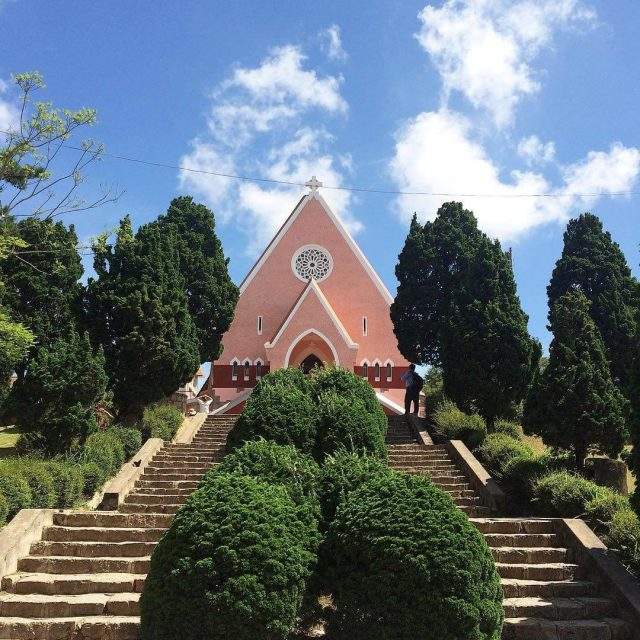
Domaine de Marie church has unique and innovative architecture located on Mount Mai Anh with many cherry blossoms.
.
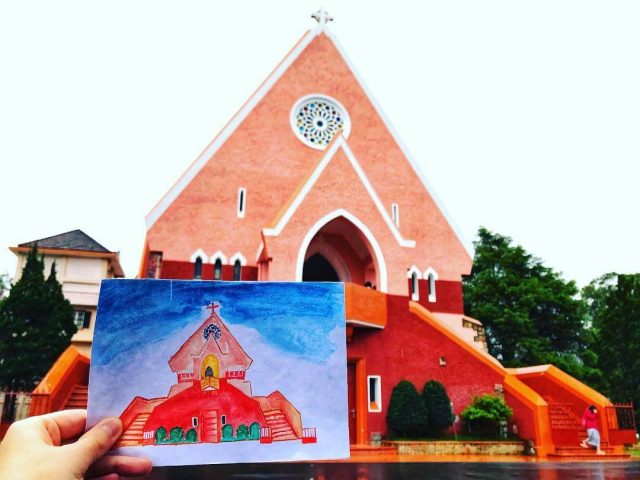
The vestibule of the church is designed in an isosceles triangle
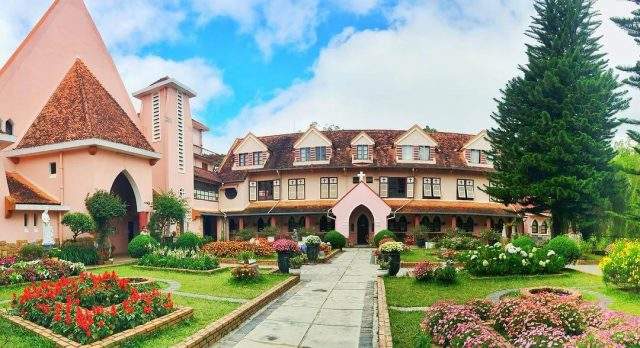
The church campus has many flowers, such as hydrangeas, Mem Wolves, and Hai Tien.
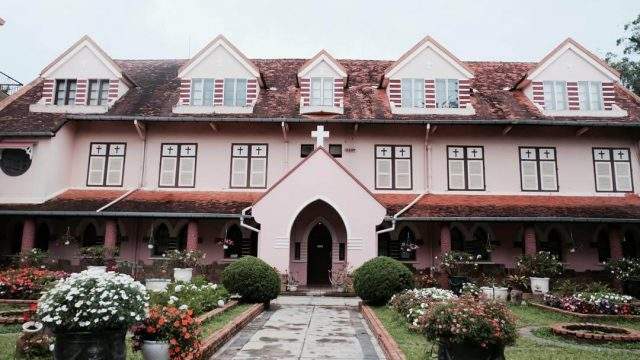
Behind the church is a complex of buildings built in an innovative style compared to 17th-century European architecture
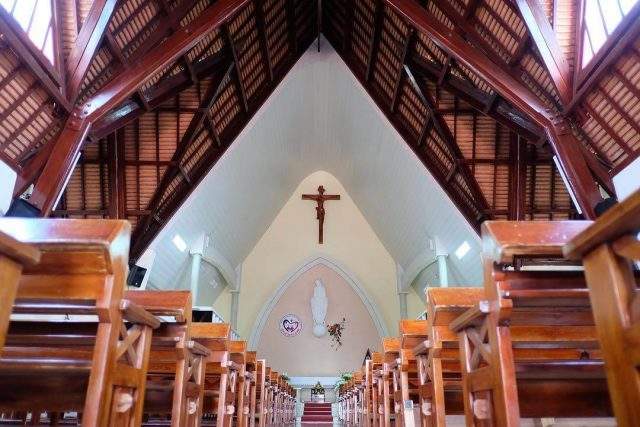
Architecture inside the church
